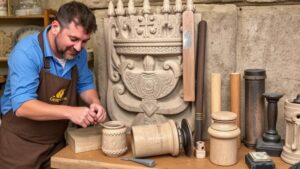Exploring Historical Leather Crafting Workshops for Forgotten Tools
Exploring Historical Leather Crafting Workshops for Forgotten Tools
Leather crafting has a rich history that spans across continents and cultures, showcasing both artistry and utility. The exploration of historical leather crafting workshops reveals not only the craftsmanship involved but also the tools that have largely vanished from modern usage. This article delves into the significance of these workshops dating back to the late Middle Ages, particularly focusing on workshops in Europe, with case studies from England and Italy, and examines the tools that have been forgotten over time.
The Role of Leather Crafting in History
Leather production has been crucial in many societies, serving functional, ceremonial, and economic purposes. In the late Middle Ages, particularly during the 14th and 15th centuries, towns in England and Italy became centers for leather goods, which included items such as footwear, armor, and domestic goods. According to historical records, the leather industry provided livelihoods for thousands of craftsmen across Europe. For example, the city of Florence became especially notable for its fine leatherwork, spurred by Guild regulations that established skill standards and trade secrets.
Case Study: Leather Workshops in 15th Century England
The leatherworking guilds in 15th century England, particularly in towns like London, Bristol, and York, were the backbone of the craft, producing items from saddles to gloves. Each guild regulated the quality of leather and the apprenticeships required to ensure that skills were passed on through generations.
Among the workshops, “The Worshipful Company of Cordwainers” emerged as one of the most prominent, focusing on shoe production and leather goods. Historical manuscripts indicate that as early as 1439, the company established its guild regulations to control the trade standards and protect the rights of craftsmen.
- Documented regulations listed the types of leather permissible for specific products.
- The required length of apprenticeships, traditionally seven years, ensured that craftsmanship was thoroughly learned.
The Tools of Leather Crafting
Leather crafting requires a specialized set of tools that have evolved over time, many of which have become obsolete. Understanding these tools gives insight into the craftsmanship of yesteryears. Traditional tools include:
- Bodkin: A pointed tool used for making holes in leather or guiding thread through difficult areas.
- Fleshing knife: Used for separating the flesh from the hide during tanning.
- Pricking irons: Tools specifically designed for making stitch holes in the leather before sewing.
Each tool played a significant role in ensuring that leather goods were crafted to high standards, allowing for durable and aesthetically pleasing products. A survey of existing workshop inventories from the 16th century indicates a marked decrease in the variety of tools now in modern usage. For example, pricking irons were standard tools for shoemakers, but current practices often utilize machines that eliminate the manual skill involved.
Case Study: Italian Leather Crafting Techniques
Italy’s leatherworking reputation is historically linked to its craftsmanship, particularly in cities like Florence and Venice. Workshops during the Renaissance were known for their elaborate designs and high-quality leather goods. In Florence, the 13th-century guild “Arte dei Cuoiai” oversaw leather production, including strict regulations regarding the preparation and crafting processes. Tools such as “gallo,” used for cutting leather, showcase the specificity of the equipment used.
Plus, historical research indicates that Florentine artisans utilized tools made from rare materials, indicating a socio-economic status among craftsmen who could afford the best. 16th-century texts of Italian artisans demonstrate a depth of knowledge and detail regarding these specific tools.
Conclusion
The exploration of historical leather crafting workshops provides a window into the forgotten tools and techniques that characterized the leather industry over centuries. An understanding of these tools, alongside the socio-economic framework of the trade, reveals both the artistry and labor behind leather goods. As interest in historical crafting techniques grows, the rediscovery of these tools invites contemporary artisans to appreciate and revive lost traditions.
In summary, while modern technology has supplanted many traditional leatherworking methods, there is much that can be learned from the practices and tools of the past. A renewed interest in historical craftsmanship not only benefits artisans seeking to preserve their legacy but also enhances the consumers appreciation for handmade goods.


